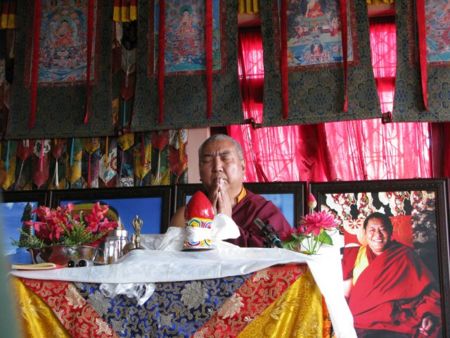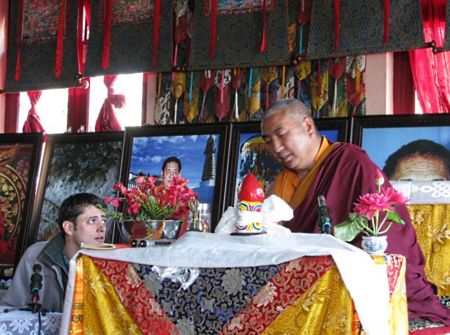Khenpo Namdrol 2008 Teachings on Buddha Nature

Khenchen Namdrol Rinpoche is currently teaching the Rigpa Shedra on Mipham Rinpoche's work on buddha nature (Skt. sugatagarbha): The Lion's Roar: A Commentary on Sugatagarbha.
We will update this page on a daily basis with recordings of the teachings as we progress. The recordings contain the Tibetan teaching and its live English translation.
Recorded during Shedra East 2008-2009 in Pharping, Nepal

Study Material
Douglas Duckworth has recently published an English translation of the text we are studying:
- Douglas Duckworth, Mipam on Buddha-Nature. The Ground of the Nyingma Tradition, State University of New York Press, 2008. ISBN 978-0-7914-7521-8. The translation is contained in Appendix 1.
The Tibetan is contained in Mipham Rinpoche's collected works (gsung 'bum), Volume pod 4 pa
- bde gshegs snying po'i stong thun chen mo seng ge'i nga ro p. 563-608. See TBRC
The Lion's Roar: A Commentary on Sugatagarbha
By Jamgön Mipham Rinpoche
Prologue
- 1st teaching, 16-Dec-2008: How is buddha nature taught in sutra, tantra and Dzogchen?
online: 20081216PH0930KN.mp3
Introduction
- 2nd teaching, 17-Dec-2008: Our teacher the Buddha has taught on buddha nature emphazising sugatagarbha's essence (ngo bo) by teaching on emptiness. On other occasions, he gave clarifications on its nature (rang bzhin) by explaining its primordially present qualities. It is crucial to understand that those two aspects are in union.
online: 20081217PH0930KN.mp3
See Tibetan: Mipham gsung 'bum, Vol 4., p. 564-565. English: Duckworth, p.147-148
- 3rd teaching, 18-Dec-2008: Accuracy of scriptures can be examined by the three types of investigation and understanding establishes irreversible trust by means of the three types of valid cognition.[1] How can buddha nature (tathagatagarbha) be established in this way, as being empty in essence while cognizant in nature?
online: 20081218PH0930KN.mp3
See Tibetan: Mipham gsung 'bum, Vol 4., p. 566-567. English: Duckworth, p.148-149
A. Proof of the Presence of the Tathagatagarbha in all Sentient Beings
The Uttaratantra Shastra says:
- Because the perfect buddhas’s kaya is all-pervading,
Because reality is undifferentiated,
And because they possess the potential,[2]
Beings always have the buddha nature.[3]
The Mistaken Apprehension of Others
- 4th teaching, 19-Dec-2008: A refutation of the position of early Tibetan commentators concerning the interpretation of the meaning of the Uttaratantra Shastra verse. Neither is the fact that the dharmakaya pervades everything sufficient for the existent of the nature (Tib. rigs) nor can suchness be simply understood as mere emptiness in the sense of the approximate ultimate.
online: 20081219PH0930KN.mp3
See Tibetan: Mipham gsung 'bum, Vol 4., p. 567-569. English: Duckworth, p.149-151
Nature (rigs) as the union of the two truths
- 5th teaching, 20-Dec-2008: The Union of the two truths, the basic space (Skt. dhatu) that is free from all webs of conceptual elaborations, the wisdom of one's own rigpa which knows itself, the naturally pure dharmadhatu or emptiness, is the actual nature (Tib. rigs). The basic space of phenomena (dharmadhatu) is the way in which the indivisible union of appearance and emptiness abides without falling into any category. The sugatagarbha is the indivisible union, beyond any possibility of being united or separated, of the primordial purity of the cause and effect of samsara, and untainted appearances which are natural and spontaneous clear light.
online: 20081220PH0930KN.mp3
See Tibetan: Mipham gsung 'bum, Vol 4., p. 569-572. English: Duckworth, p.151-153
References
- ↑ (tshad ma gsum) Another expression for the three types of investigation
- ↑ The alternative translation for potential (Tib. rigs) used during the teachings is nature or the Sanskrit gotra (here go comes from guna, quality. tra means to protect. So gotra means to protect the qualities (Tib. yon ten skyob pa) [RY])
- ↑ Sublime Continuum, I, 27. Translation Adam Pearcey, Compendium of Quotations VI, p. 49